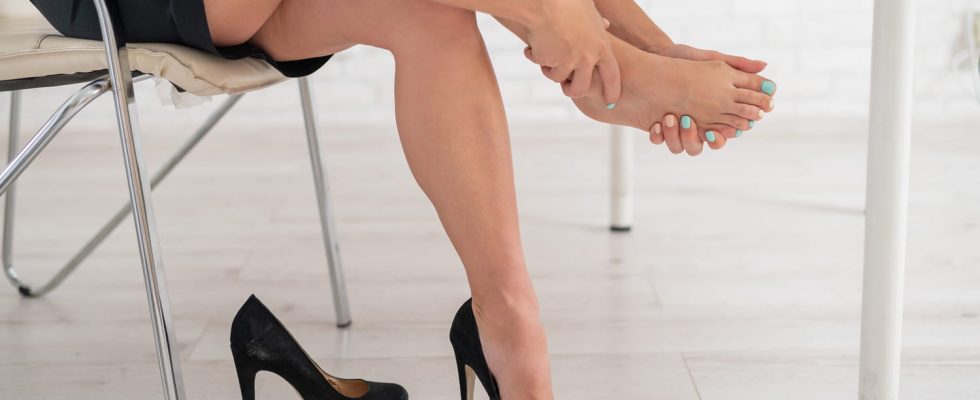This painful condition is a fairly common condition affecting the forefoot. It concerns women in 80% of cases. How does this syndrome arise? What are the signs? What are the possible treatments ?
Definition: what is Morton’s syndrome?
Also called “Morton’s neuroma”, this syndrome is a disease that affects the foot. The syndrome is characterized by a compression of a sensory nerve in the forefoot, at the end of the metatarsals, bones preceding the toes. The nerve most often affected is between the 3rd and 4th metatarsals, often between the 2nd and 3rd, or even both. This syndrome mainly affects women over the age of 50.
What causes Morton’s syndrome?
There are two possibilities for its development. “Either the disease is a entrapment syndrome with compressionor Morton’s neuroma would be secondary to phenomena of nervous irritation repeated by the microtraumas due to walking and static disorders possible damage to the forefoot and also poor footwear that is often more aesthetic than comfortable (heel too high, soles too thin, toe too narrow, etc.), explains Dr. Laurent Grange, rheumatologist.
What are the symptoms of Morton’s syndrome?
This condition is characterized by:
- A bulgethe size of which varies depending on the case.
- Of the tingling that get worse over time
- Of the strong pains that increase when walking or with prolonged standing
- Sometimes the feeling of electric shocks at the front of the foot which radiates towards the toes.
“In the face of any acute localized pain, this disease must be sought, recommends Dr. Grange. This pain can be paroxysmal, with the type of very intense electric shock. Nevertheless it can be continuous, sometimes influenced by walking. It is very often calmed by the removal of the shoe”.
The podiatrist or general practitioner can palpation of the foot evoke the diagnosis. The pain caused is violent and corresponds perfectly to the anatomical location of the nerve. The reference examination to confirm the clinical examination is ultrasoundmuch more reliable than MRI, due to the maneuvers carried out by the radiologist with his probe.
What are the treatments for Morton’s syndrome?
“THE medical treatment is often sufficient when Morton’s syndrome results only in fleeting and well-tolerated pain. It consists of two corticosteroid injections 2 weeks apartexplains the rheumatologist. Of the self-rehabilitation exercises are recommended within 8 days seepage“. Of the Plantar orthoses are also prescribed to reduce anterior hyper-support. “If these orthoses are not necessary, shoe tips are given to the patient: lower heels, wider front end, good quality sole“, specifies Dr. Grange. In the event of failure of this treatment, or possibly in the presence of very intense pain, the surgery can be considered.
Can Morton’s syndrome be cured naturally?
The application of pocket of cold can help to calm the twinges, the feelings of heat and the pains caused by the syndrome. A massage with an arnica-based gel will also be lifesaving. Performing pressure-sliding movements under the foot will calm the pain.
What shoes for Morton syndrome?
Opt for wide shoes at the front of the foot, to allow the toes the opportunity to spread out. Also make sure she has good cushioning in order to limit the repetitive impact of shocks to the ground, and a good arch support to reduce pressure on the soles of the feet. The use of soles can also enhance the comfort of your feet.
When to operate in case of Morton’s syndrome?
If treatment fails, surgery will be offered. “When the neuroma is largeit is removed by a short scar on the dorsal side of the foot, explains Dr. Cyrille Cazeau, orthopedic surgeon. The operation is performed under local anesthesia in outpatient surgery. The disadvantage of this ablation is the appearance of a loss of mirror sensation on both toes that are side by side. When the neuroma is smaller, one can perform a decompression of it without removing it, by a percutaneous technique (2 mm incision)”. Dressings are to be made for about ten days. The resumption of normal activities is possible 1 to 2 months after the intervention.
Thanks to Dr. Cyrille Cazeau, orthopedic surgeon at the Clinique Victor Hugo, in Paris and to Dr. Laurent Grange, rheumatologist at the CHU Grenoble-Alpes and president of the French Association for the fight against rheumatism (AFLAR).
